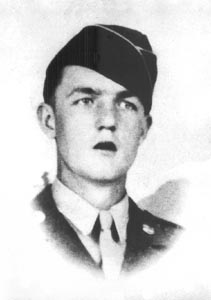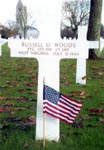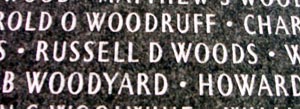

Remember...
Russell Dawson Woods
1925-1944
"In war there is no substitute for victory."
General Douglas MacArthur |
Remember...Russell Dawson Woods
|
On September 28, 1943, Russell enlisted in the US Army at Huntington, West Virginia. He was 18 years old at the time. Russell went to Camp Wheeler, Georgia, and was assigned to the 14th Infantry Training Battalion for basic training. When training was completed and the regiment was ready to leave for Europe, he was transferred to Company A, 175th Infantry Regiment of the 29th Infantry Division. In late 1943 they arrived at Tidworth Barracks in England, and spent the next several months taking part in intensive training exercises to prepare for their part in the Normandy Invasion.
The Normandy Invasion, which was known as Operation Overlord, began on June 6, 1944, and the 29th Infantry Division was assigned to the XIX Corps. The Omaha Beach area of the Normandy coast consisted of ten sectors, and the 29th Infantry landed on the Dog Green sector. The 175th Infantry Regiment was held offshore in reserve, and came ashore with the remaining units of the division on June 7th. They endured intense and deadly fire from well-positioned German troops on the bluffs and the first-wave assault companies experienced heavy losses.
The German army was entrenched in the hedgerows, which were walls of earth, some as high as 30 feet, that were topped by brush, trees, and briars that the local farmers had used for centuries to divide their fields and to protect crops and livestock from strong ocean winds. There were miles of hedgerows surrounding St. Lo and throughout the Normandy countryside, which severely limited the Allies' ability to move quickly and effectively. During the battle, the Germans were also assisted by heavy downpours of rain that turned the hedgerows into rivers of mud and water. The German army heavily defended these hedgerows with snipers, tanks, and machine guns, forcing the Americans to fight fiercely for each foot of ground that they gained. After days of intense fighting and thousands of casualties, the battle for St. Lo was won by the Allies on July 18, 1944.
After St. Lo, the 29th Infantry Regiment was attached to the United States 1st Army commanded by General Omar Bradley. Operation Cobra, a plan to move the American troops off the Cotentin Peninsula and push through the German defenses around St. Lo, was launched by General Bradley on July 25, 1944. In order for this operation to be successful, the infantry had to break through the German lines near Vire and the Lozon River. Aerial bombardment by the Allies weakened the German troops, and by July 27th, their lines had been pushed back about 15 miles. On July 30th the infantry successfully reached the town of Avranches at the end of the peninsula.
| During the various skirmishes and battles that occurred following the Normandy Campaign and during Operation Cobra, Russell Woods was reported as missing in action on July 31, 1944. His status was later changed to killed in action, and Russell was buried in the Brittany American Cemetery at St. James, France. |  Russell Dawson Woods |

West Virginia Archives and History welcomes any additional information that can be provided about these veterans, including photographs, family names, letters and other relevant personal history.